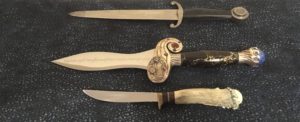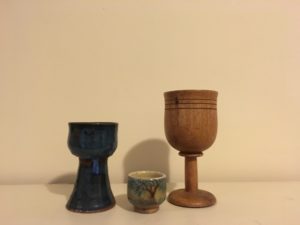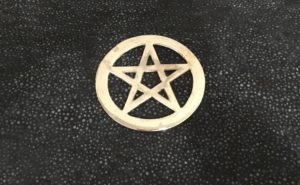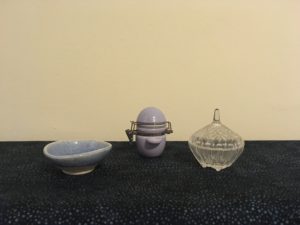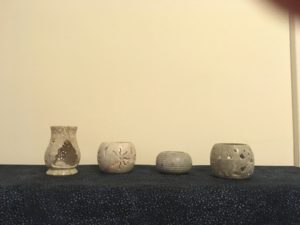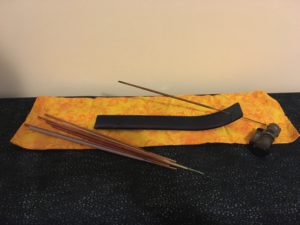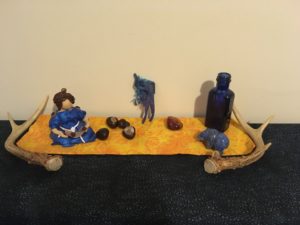People often look at the lists of tools, and go “Do I need all of that?” Humans are tool-using mammals: we do tend to pick things up and see what we can do with them. More than that, though, tools make some things things easier. The trick is using the right tools.
(Note: Unlike most articles on this site, this one has photographs. They have some description with them, but in a number of cases you can get more from the provided link.)

Why do we use tools?
Some tools are very practical:
A cup or bowl to hold water (or wine), a sharp point to inscribe a candle. And in some traditions, tools have a magical or energetic role that’s just as practical – like pentacle storing and holding energy on the altar until it’s needed.
Some tools help us sharpen our focus.
When we use the tools, we have help remembering what our main goal or intention is. (many ritual tools fall here, but also things like jewelry, amulets, talismans, and much more.)
Some tools help us direct our energy.
This is because the tool encourages that direction. Energy flows through a wand differently than through a blade, though they’re similar in some ways too.
Tools help groups work together.
When we work in a group, tools also help keep the whole group centered. They speak to our senses in multiple ways – not just hearing someone speak, but seeing the tool and the color of altar cloths, smelling incense or seasonal plants, tasting the food and drink we share in circle, hearing the voices of those in ritual or chants, and the feel of ritual robes, a friend’s hand, or a particular tool in its use.
The more senses we can include, the richer our ritual experience often is.
Tools make ritual work flow more smoothly.
We can have great and life changing rituals without these tools – but think of it like holding a story in your head, without a book or movie or play to help. We have to work harder to keep everything clear, we have a harder time creating a clear sequence, we may lose track of details or specifics.
Plus, sometimes, we just really want the full experience of turning the pages and creating the images in our own head, or of being wrapped up in the whole experience of watching an amazing performance.
The major tools:
Authors have written chapters and chapters about these tools, but a brief summary might help. Tools are often divided into two groups: personal tools (of use to everyone) and group tools (less useful, or requiring more space).
Athame
(usually pronounced a-THA-may or ath-a-MAY) : a blade used to represent will and intention. Commonly used to scribe the circle and otherwise direct and focus energy. Some traditions associate it with fire, others with air. A number of traditions have specific requirements about materials and design (for example, double edged and made of iron), others don’t care.
The two blades at the top are both athames: the top one is a fairly standard medieval dagger style, but the middle one was a custom commission. Both have black handles and are double edged blades, as is customary in some traditions.
Additional information about my athames.
Boline:
Many traditions also use a boline (BOH-leen), traditionally a white bladed knife used to inscribe candles, harvest plants, and otherwise cut things in the physical world. A moderate pair of kitchen scissors can do a good job while you’re getting started. You may also see curved blades, often used for cutting herbs.
The boline shown above is a simple blade with a slight curve, bands of color around the join, and an antler handle.
Additional information about the boline.
Wand:
Also used to direct and focus energy, but generally seen to have a less focused beam than the athame: compare a flashlight to a laser pointer. Often used to call the quarters and invite the guardians of the watchtowers, elements, or elementals to the circle, also for invocation. Some practices associate it with fire, others with air (the athame, in either case, will be the other one.) Wands can be made out of a range of natural materials: wood, copper, or crystal are all fairly common, and different materials have different energetic properties and associations.
My wands, with one partial exception, are all of wood, because I like it, though of different woods. Some are hand-made (mostly by me, with sandpaper and some wood oil). Some are made of lathe-turned wood.
I also have used a conductor’s baton to great effect as a wand more than once – I was a music major in college, and that baton has been with me since my conducting class.
Chalice:
A cup, used to hold and charge liquid in ritual. Can be made of a range of materials – ceramic and metal are common, as is glass (however, glass is fragile, and not a good choice if you’re regularly transporting it.) Associated with the element of water.
I have several chalices, partly because I find it very helpful to have at least one in a material that won’t break easily (either wood or metal). Here are the three I use most frequently: one is of blue pottery, one is a small ceramic cup with a tree done in raised clay and glaze, and one is a lathe-turned wooden chalice.
I use the small one most often for morning offerings, and the blue ceramic one most often in ritual, with the wooden one being used when I am taking altar items other places.
Pentacle:
As a tool, the representation of a five-pointed in a solid object. Usually used to charge an item or items. (For example, a piece of jewelry being charged in ritual might sit on the pentacle until time to charge it.)
People sometimes use the terms pentacle and pentagram interchangeably: the Oxford English Dictionary suggests that the pentacle is the best term term for the five pointed star in a circle. Can be made out of metal, or wood, or other related materials – but for use, it makes sense that it be something you can set things on. Associated with the element of earth.
My pentacle is a very boring but functional silver with cutouts. I like it being flat so I can easily put things on it. It came from a local-to-me Pagan store some years ago.
Group tools:
- The sword parallels the athame for group work (but it requires enough room to use safely)
- The staff parallels the wand (directing and focusing energy down a length): in this case, almost always wood.
- The cauldron is a central focus for some kinds of group work – for scrying, for burning things safely, etc. It parallels the chalice.
- The besom or broom is often seen as the pentacle’s parallel. It is used to sweep out unwanted energy, or to help get energy moving.
Other useful items:
Some traditions require various of these. Others just make use of them, and some ignore them entirely!
Cloths:
Different paths have different desires for altar cloths. (Though I recommend things it is easy to get wax and wine stains out of.) My preference for home use is a yard or two of quilting fabric in an appropriate color, big enough to cover whatever space you want to use as an altar. It’s inexpensive enough to be easy to replace if you need to, they come in all sorts of seasonally interesting patterns and designs, and if you don’t wash them frequently, you may not even need to hem them, but hemming is very straightforward compared to other kinds of cloth.
Personally, I like a nice sedate batik design for a combination of visual interest without distracting from the altar, but as you can tell by these photos, my tastes in decoration are pretty sedate.
Various small dishes, plates to set candles on, etc.
A nice range of 3-8 small dishes can be very useful for all sorts of little things (herbs, loose incense to add to a censer, salt, water, etc.)
Salt and holy water (usually held in two small dishes).
I prefer sea salt and there are many methods out there for making consecrated water. Some people like to get the water from a running water or rain – I admit I just as often use tap water when I need it.
These are some sample dishes, including an example of the kind of small dish I find very useful. (Also great for small amounts of herbs). The center jar is from a kitchen supply store (also a great source of ritual items) and the crystal container was a gift, but sometimes easier to use in ritual.
Candles
(commonly to represent the deities, any other entities invited to ritual).
Common materials include beeswax (generally the most expensive option), soy, or paraffin. Small tea lights are generally very cheap (you can often get dozens for a dollar or two at home-decor stores), and will burn for 3-5 hours pretty reliably. A small candle (like a birthday cake candle or thin taper) can be really helpful in lighting other candles.
If you aren’t able to use candles, there are great LED ones out there now, some that plug in, and some that have batteries. You can usually get them extra cheap right around the winter holidays.
Here are some different examples of candle holders. The top image has four candleholders I use for deity and other candles on my altar. (When I’m working with different deities than my personal working, I use different candles and holders.)
The stone candle holders in the second image are what I use for elemental altars. They’re of the same basic kind of stone, but they reflect different elements: a lacework tracery of light for air, suns and solar rays for fire, a pool for water (round and flat) and the one on the right has a lovely elephant and forest plants carved into it.
If you’re getting started, a set of rainbow colored glass tea light holders can be a very practical choice. You can use four of them for element or quarter candles, use one for candle magic in an appropriate color, etc. (I actually don’t have a set right now because some of them didn’t survive my last move.)
Incense (and holder, censer, etc.)
Incense comes in three common forms: loose (which must be burned on a charcoal tablet in a censer or similar object), stick (which is a long stick that burns down to an end: needs a stick holder), or a cone (which can burn on any flame-proof dish, trivet, etc.). If you’re allergic to incense, you might check out this page on alternatives to incense. .
Some people use an oil burner with essential or perfume oils instead: you can get burners for $10-15 at many esoteric stores, and essential oils from $8-15 for a bottle of less expensive materials that will last you a long time (since you use them a couple of drops at a time.) Think carefully about any allergies first: many esoteric stores offer some kind of sample of incense to try out.
For reasons having to do with my tradition’s specific practices, I always use stick incense. Here’s a stick incense holder (mine is made of blue glass) along with some other sticks and a lighter. (Regular cigarette lighters or grill lighters also work.)
Candle and incense tools:
I use a lighter for the first light, and then light everything off a single candle on my altar. This satisfies my artistic impulse, and means I don’t have to fight with either lighter or matches during ritual. You may also want a fan to waft the incense with.
Here you can see a wooden fan (good for wafting incense), a candle snuffer, and three small candles used to light other candles without being difficult to light.
Images, statues, etc. of particular deities and other items for altars.
You can be as simple or as fancy with these as you like. (Starting simple is a really good idea). Drawing your own – even if you don’t think you’re a good artist – can be particularly moving. There are plenty of other options, too.
This is a polymer statue I made of Hypatia (a philosopher and astronomer popularly associated with the Library of Alexandria, though the history’s more complicated than that.) I honour her as an ancestor of profession. Since it’s hard to find good images of her, I made my own of polymer clay. Here, she’s reading a scroll.
Other decorations.
These might be simple seasonal plants (evergreen in winter, a wildflower or two in summer, etc.), appropriate colored ribbons tied together into a fall of different colored strands (shades of blue for water, red and orange for fire, pastels and pale colors for air, greens, browns, grays for earth). They might be other items you collect over time that please you.
Here are some decorative items in my collection, just to give you a sampling. You can see antlers, a statue, horse chestnuts (I love the feel of them, and the look on a fall altar), a fabric dancing figure (there’s a pin on her back), a piece of polished carnelian, a cobalt glass bottle, and a carved lapis bear with a fish in its mouth. They’ve all been on my altar at one point or another for different reasons. You can see the decorative items in more detail elsewhere on the site.
Conclusion:
Your choice in tools should be guided by what you need them to do (that’s practical), safety (that’s sensible), and then by your own tastes and what’s possible for you. It’s entirely reasonable to start very small and simple, and add things occasionally over time – my collection has been built up over 15 years!
For a sample of what you might pick up in which order, and some ideas for inexpensive options, check out my page outlining a sample low-budget set of options for someone initially exploring Wiccan-based practice.
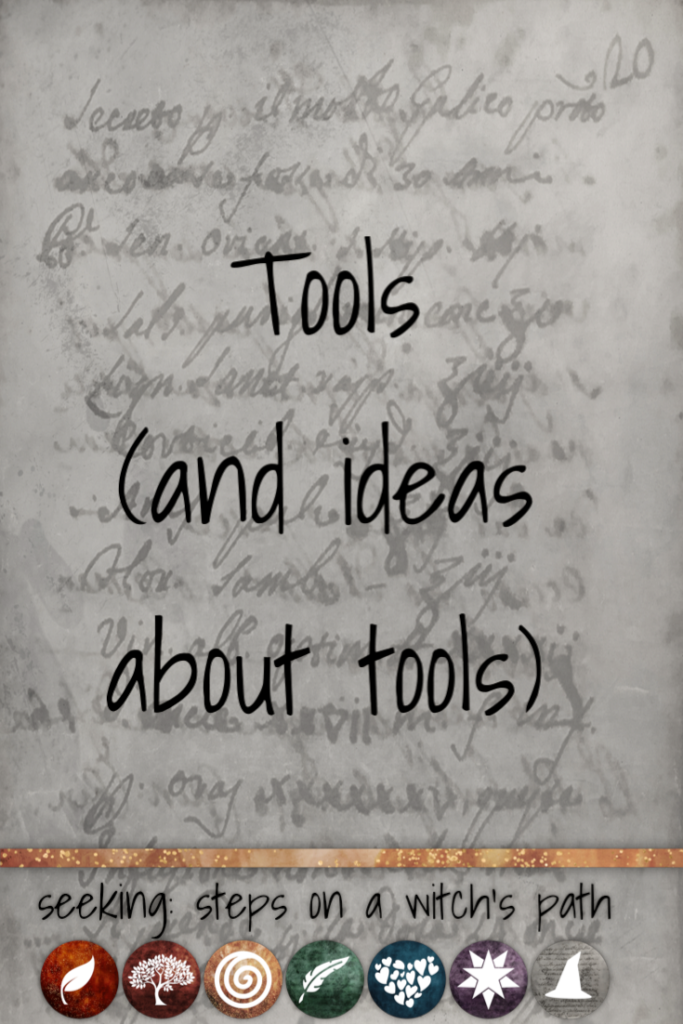
Last edited January 1, 2017. Reformatted November 2020.

